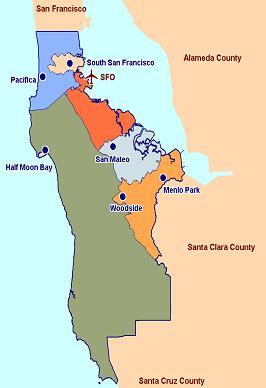General Information
San Mateo County began its paramedic emergency ambulance service program almost 30 years ago. One city, South San Francisco, became a paramedic provider in 1975. In 1976, San Mateo County became the first California county to conduct a Request for Proposal (RFP) process granting an exclusive operating area for emergency ambulance service. Over the next two years a countywide system of paramedic-staffed ambulances was established.
Over the next twenty years, San Mateo County periodically
conducted RFP processes to award the county contract for
emergency ambulance service. As a result of these competitive
processes the EMS system has continued to improve its service to
the community and has become a leader in California EMS. The most
recent RFP process was conducted in 2009 with the contract
awarded to American Medical Response, the incumbent provider.
However the services are provided in a public/private partnership
model that includes both paramedic emergency ambulance service
and paramedic first response. This collaborative arrangement has
received a number of awards from the National Council for
Public-Private Partnerships, International City-County Management
Award for Outstanding Partnerships, the League of Cities Helen
Putnam Award for Excellence in Public Safety, and the
International Association of Fire Chiefs.
Some of the key features of the current San Mateo County EMS
system include:
- centralized dispatch for all 911 medical emergencies including fire service first response and emergency ambulance
- a response time performance-based contract for emergency ambulance and paramedic first response
- supportive and involved emergency department physicians and nurses
- excellent air ambulance providers
- two Level I trauma centers, both outside the county but in close proximity to the north and south county lines
The County establishes maximum emergency ambulance user fees within the contract for services. User fees financially support the service (both ambulance provider and fire service first response); there is no county subsidy.
System Design
As a result of a four year planning process and recent Request for Proposal Process, on January 1, 1999, a new system for providing emergency medical responses went into effect. Firefighter paramedics on fire engines and the American Medical Response (AMR) ambulances respond to 9-1-1 emergency medical calls. The system is a public/private partnership between AMR, the fire service agencies in San Mateo County, and the County Health Services Department’s EMS office. AMR contracts with a Joint Powers Authority, made up of 17 fire service agencies, to provide paramedic first responder services.
The system benefits patients with a faster paramedic response than the previous model and better integrates the care provided by firefighters and ambulance paramedics. A single dispatch center, San Mateo County’s Public Safety Communications in Redwood City, performs all dispatch services for fire departments within the County as well as for the emergency ambulances. The system dispatches the closest fire engine and ambulance to every medical incident regardless of local fire agency boundaries.
Oversight of the system, both operational and medical, is provided by the EMS office of county Health Services, which holds the master contract with AMR West for both ambulance service and paramedic first response.
The previous system provided paramedic ambulance response with a 9-minute response time standard in the more populated areas. In the current system, fire engines with paramedics on board respond within 7 minutes. Emergency ambulances continue to be staffed by paramedics but have a response time standard of 13 minutes. The cost savings to AMR for the extended response time is used to subsidize the fire departments for providing the paramedic first response service.
This bold approach of merging public and private services, with the County as the oversight agency, required a high degree of planning and cooperation. It is the result of a four-year planning process that involved medical professionals, city managers, fire agencies, ambulance providers, consumers and county staff.
